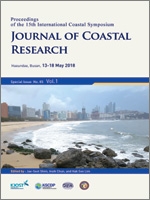Park, J.-I.; Kim, j.-H.; Kim, J.H., and Shim, J.H., 2018. A New and Effective Transplanting Technique Using Wire Netting for Restoration of the Surfgrass, Phyllospadix japonicus, in Exposed Rocky Shores. In: Shim, J.-S.; Chun, I., and Lim, H.S. (eds.), Proceedings from the International Coastal Symposium (ICS) 2018 (Busan, Republic of Korea). Journal of Coastal Research, Special Issue No. 85, pp. 326–330. Coconut Creek (Florida), ISSN 0749-0208.
The surfgrass Phyllospadix japonicus is an abundant seagrass along the exposed rocky shores of the Korean peninsula. However, many surfgrass meadows on this area have been severely damaged by anthropogenic factors, leading to a growing interest on the restoration of surfgrass habitats. Few attempts have been made to develop transplanting techniques for surfgrass, owing to the low transplant survival in high-energy rocky shores. The present study evaluates the performance of a new transplantation method for P. japonicus based on affixing surfgrass transplants to a stainless steel wire rope netting on the underwater bedrock. In November 2013, P. japonicus individuals were transplanted to the eastern coast of the Korea peninsula using this newly developed wire netting method, and their shoot density, morphology, and growth was observed for 23 months and compared to that of a natural population established nearby. Transplants density gradually increased without significant initial shoot loss during the first year, and rapidly increased up to 3.4 fold during the second year. Transplants size significantly decreased after transplantation and was similar to that of natural shoots approximately 16 months after transplantation, time at which leaf growth was also similar between the two populations. Rhizome elongation in transplanted P. japonicus was approximately 127.9 mm during the study period. Because P. japonicus successfully established at the study site, the transplantation of surfgrass using the wire netting method might offer an effective approach for the restoration of its meadows.





